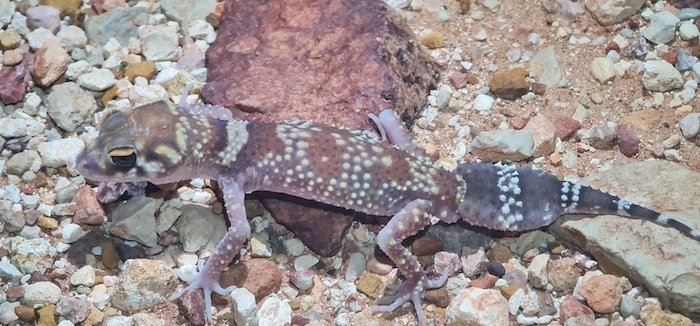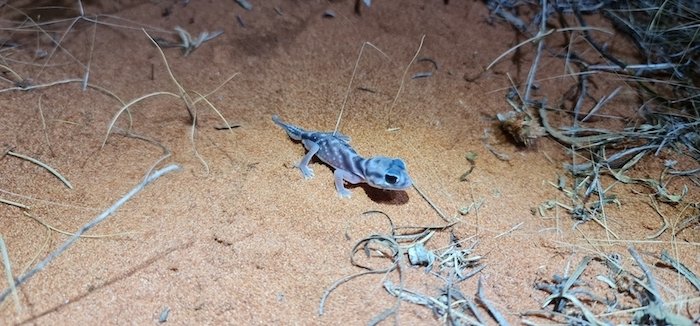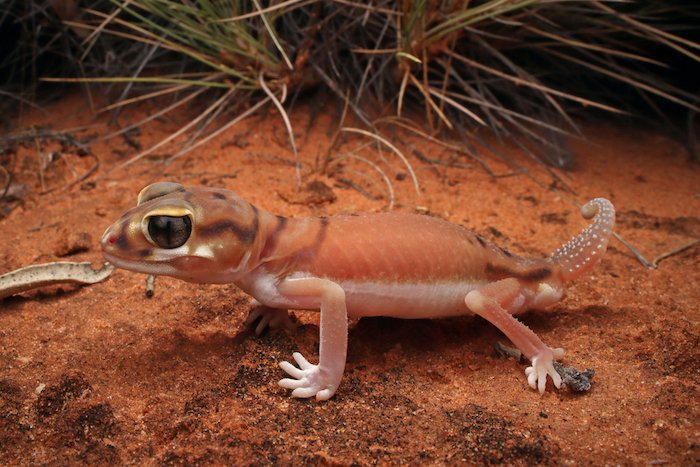Gecko Ditches Pads for Cleats
Observation by Connor Margetts, Public Domain, via iNaturalist
Carphodactylidae
by Inspector Barry Mins on May 7, 2024Hey kids, welcome back to our series on the mysteries of created kinds.
It’s been a few weeks as the Inspector has been tied up on other cases. However, this week we head to Australia looking for a unique group of geckos.
These geckos lack the toepads commonly found in other geckos. Instead, they use claws to climb. Their habitat varies, with some species happily inhabiting the same spaces as humans, climbing walls, and hanging from shaded overlooks.1 They rarely venture more than a few feet from the ground. Others are either rainforest dwellers or restricted to rocks.2 Most species are nocturnal, avoiding the Australian sun during the day and emerging at night to forage.3 Their preferred diet is insects and other arthropods, but they will take larger prey if they can swallow it.4
This kind has a unique method of determining males and females. Humans use an X/Y system to determine male and female. Males in humans are XY, while females are XX. These geckos use a Z/W system, where males are ZZ and females are ZW.5 Females usually lay two eggs under cover where the ground is at least slightly moist.6 Incubation time is just over two months with the young usually hatching at night.
Has anyone figured it out yet? This week’s kind is the Carphodactylidae—the southern padless gecko kind. Next week, we head to Southeast Asia looking for a small group of toads.
Try out this fun word search!
Clue
Your clue for the week is:
One species of this kind is referred to as “Gollum’s toad” after a well-known character from J.R.R. Tolkien’s Lord of the Rings.
Ask a Question
Have you ever had a question about created kinds but didn’t know who to ask? Have you ever wanted to learn more about your favorite kind? Well, now you can! You can ask me, Inspector Barry Mins, a question! Have your parents help you fill out this form, and you might get your question answered in my column! If you have any questions about created kinds, feel free to send them my way!
Footnotes
- Matthew Mo, “Habitat Selection of the Broad-Tailed Gecko Phyllurus platurus in an Urban Sydney Bushland Remnant,” Australian Zoologist 37, no. 1 (2014): 95–101, https://www.researchgate.net/profile/Matthew-Mo-2/publication/263280180_Habitat_selection_of_the_Broad-tailed_Gecko_Phyllurus_platurus_in_an_urban_Sydney_bushland_remnant/links/571824ea08ae986b8b79e8e5/Habitat-selection-of-the-Broad-tailed-Gecko-Phyllurus-platurus-in-an-urban-Sydney-bushland-remnant.pdf.
- Patrick J. Couper, Ross A. Sadlier, Glenn M. Shea, and Jessica W. Wilmer, “A Reassessment of Saltuarius swaini (Lacertilia: Diplodactylidae) in Southeastern Queensland and New South Wales; Two New Taxa, Phylogeny, Biogeography and Conservation,” Records of the Australian Museum 60, no. 1 (2008): 87–188, https://media.australian.museum/media/Uploads/Journals/18061/1492_complete.pdf.
- P. P. Cullen and M. H. M Menz, “Occurrence of the Barking Gecko Underwoodisaurus milii (Bory 1825) (Gekkonidae) in the Pilbara Region, Western Australia,” Journal of the Royal Society of Western Australia 89, no. 2 (June 2006): 89–90, https://www.researchgate.net/profile/Myles-Menz/publication/246548276_Occurrence_of_the_Barking_Gecko_Underwoodisaurus_milii_Bory_1825_Gekkonidae_in_the_Pilbara_Region_Western_Australia/links/0046351ec00bad9df5000000/Occurrence-of-the-Barking-Gecko-Underwoodisaurus-milii-Bory-1825-Gekkonidae-in-the-Pilbara-Region-Western-Australia.pdf.
- B.D. Wellington, R. A. How, and J. Dell, “Reproductive and Dietary Biology of Nephrurus and Underwoodisaurus (Gekkonidae), in Western Australia,” Records of the Western Australia Museum 14, no. 4 (1990): 449–459, https://www.researchgate.net/profile/Ric-How/publication/267824755_Reproductive_and_dietary_biology_of_Nephrurus_and_Underwoodisaurus_Gekkonidae_in_Western_Australia/links/591bed2d0f7e9b7727d8b1ff/Reproductive-and-dietary-biology-of-Nephrurus-and-Underwoodisaurus-Gekkonidae-in-Western-Australia.pdf.
- Michail Rovatsos, Barbora Augstenová, Eleonora Pensabene, Milan Veselý, and Lukáš Kratochvíl, “Are Geckos Special in Sex Determination? Independently Evolved Differentiated ZZ/ZW Sex Chromosomes in Carphodactylid Geckos,” Genome Biology Evolution 13, no. 7 (2021): https://academic.oup.com/gbe/article-pdf/doi/10.1093/gbe/evab119/39351234/evab119.pdf.
- Andreas Laube and Robert Porter, “Captive Maintenance and Breeding of Some Ground Dwelling Australian Geckos Part IV: Underwoodisaurus milii (Bory de Saint-Vincent, 1823) and Underwoodisaurus sphyrurus (Ogilby, 1982)” Gekko 4, no. 1 (2004): 23–32, https://www.livefoods.com.au/image/data/PDFs/Gekko_4_1_Underwoodisaurus.pdf.
- © 2024 Answers in Genesis
- Privacy Policy
- Contact
- About




